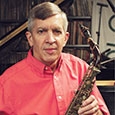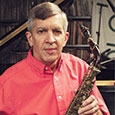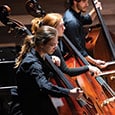This is my 50th year of putting out Play-A-Long book/recording sets. I started in 1967 with Chuck Suber, who was the editor of Downbeat magazine. He said, “If you make an LP and a booklet, I will buy 100.” So, I decided to give it a try. Fifty years later there are millions of people who have practiced and played with them. I never intended to put out more than one; I didn’t think there would be any need for more than one. We have 133 now.
I didn’t dream when I started that some of the Play-A-Longs would teach scales and chords. I learned along the way that students did not know their scales and chords. That was why when they played the blues, they had no idea what they were doing. We released a number of pedagogical ones, and these changed the way musicians practice. I think people realized that if I thought it was important, then they should practice it. I hope the idea of playing whatever you want and just letting your fingers go wild during an improvised solo has been reduced a bit. If the chord is a C chord, that is the basic scale students should play off of.

Improvising Without Fear
Improvising can be scary, and we should dispel the myth that someone might not have the ability to improvise. One way to do that is to put students in a situation where they start out playing just on a scale. They need to develop confidence. The reason for the emphasis on practicing scales and chords, as well as learning melodies like Perdido or Satin Doll and numerous blues in the keys of Bb and F is that these are part of the basic jazz repertoire. Everybody has to do this sooner or later. If you wait until later, that probably means that you wasted a lot of time earlier just beating around in the bush and trying to find something that sounded good or impressed others.
If all students were taught to improvise as they come up through school, I guarantee that musical instrument companies would love it. People would graduate from school and continue to play their instruments and not retire them because they know how to improvise. They could play anywhere just for the enjoyment. Some do continue, but I would bet that the 98% who did not learn to improvise, never play music anymore after graduation. They listen to it, but they don’t play it. That’s sad.
The ego plays a part in this, too. It does not want you to sound bad. Once you start improvising the ego does not want you to play wrong notes, get lost, and stop at the wrong time. Nothing could be worse. The ego will discourage people from signing up for jazz band due to the unknown.
Learning How to Listen
People who want to learn jazz have to listen to jazz. Many people listen to big band music, but the soloing is limited and the backgrounds can be busy and complex. I strongly suggest listening to combos instead.
Ear training is also important. I was recently at a college and played a blues on my saxophone. I went slowly and outlined the key notes so anyone who had listened to jazz would know within four or five measures that I was playing a blues. I didn’t play a melody, I just improvised. Nobody raised their hand that they recognized the blues.
Ear training has to be coupled with application, but that is often overlooked. People may practice the scales and chords, but when they start to improvise they don’t get the relationship of the roots, thirds, fifths, and sevenths and how important they are for both players and listener. Many people rely on bass, guitar, and piano to lay down the harmony, and then they play seemingly randomly. They would never speak that way because their sentences would make no sense. When we talk, we are always communicating. In jazz, it has gone on way too long that someone picks up their instrument and solos for 12 bars, having no musical relationship to the piano, bass, guitar, and drums. This is sad, but it can go back to their teachers lack of information and training.
Training Every Teacher
If a teacher does not have someone to help them learn about improvisation or they don’t seek outside instruction about how to teach it, this can result in choosing big band charts with no solo space. If there is no improvisation, it’s not really jazz. I don’t feel colleges and universities have caught up with what is needed for band directors to go out and teach jazz band or have a combo in a high school or middle school that meets every day. Few colleges have a required course on teaching jazz that includes learning what materials to buy and how to teach students to improvise. Long ago I thought this would eventually be covered at the college level and there would be no future need for our Summer Jazz Workshops.
If every college student might end up in a job with a jazz band or a combo, we should not let them out of college unless they can improvise a decent blues solo, play two or three tunes, describe the tunes harmonically and rhythmically, and list what they might expect from a beginning jazz band starting on this blues. All college music graduates should be required to take at least two semesters of jazz combo/theory/ear training before graduation. This would help raise music ed standards and give these new teachers the confidence they need to approach their new jobs with enthusiasm. Too many band directors learn on the spot, which is unfortunate.
I taught an improv class for 12 years at the University of Louisville. Every music education major had to take my class. I had violins, trombones, vibraphones, and everything else. They learned a great deal in one semester’s time. That doesn’t mean that they ended up being improvisers, but they at least knew what to do if they got a job. They had some basis to start.
I have always thought it was important to study with a jazz teacher. You may also be studying with a classical teacher on sound, articulation, and how to read, but it is great if that person is interested in jazz. I have noticed over the last 20 or 30 years that the jazz players who have become educators are really well-equipped. Once you can do something yourself it is easier to teach it. When you haven’t been shown how to do it and your job is to teach it, this can be nervewracking.
The Initial Breakthrough
When I was a 21-year-old teacher in Seymour, Indiana, I had a flute player with a great sound and great technique. One day we had ten minutes left in her lesson, so I asked her to improvise on a D minor scale over two octaves. There was a little piano in the practice room, so I played a walking bass line and chords in that key and told her to play whatever she wanted to play. I had never asked anybody to do this before. Right away I realized she was playing nice two-bar phrases, which she was imagining in her head. We did that for a couple of minutes, and I stopped and said, “let’s go up a half step.” We went to Eb dorian. I had her play the scale two octaves, then we tried improv again, and she did just great. We came back down to D minor and played it again, this time with the chord progression from So What. That’s what got me started – a young girl who could improvise with nice phrases without ever having done it before. She didn’t have a stack of records like jazz players do and hadn’t heard jazz before. That made me wonder if everyone could do this.
The Sounds in Your Head
I discovered that if I sit at the piano and slowly play a random but logically flowing chord progression, anyone can sing a solo to go along with it. The voice is a magical instrument, and the mind can sing great solos if the tempo is not too fast and the chord progression is not difficult. I have done this many times and that’s where my “Anyone Can Improvise” words came from.
Once I was giving a clinic in New Hampshire. I asked for a volunteer to come up with their saxophone and try to play along with me while I played some random chords on the piano. The volunteer sounded awful. Then I asked him to grab the microphone and sing for me instead, and he sounded great. He included notes that with diligent practice might take three years to play on his instrument. It was very musical but he had no knowledge of scales or chords or jazz in general but his musical mind knew. All of the other students applauded because it sounded like music. Unless someone is nervous, nine times out of ten people will sing a good solo. It made me a true believer in our inner musical mind. It’s the instrument that holds us back. An instrument cannot match what a person hears in the mind. While in the early stages of learning improvisation, that is just enough to make someone give up. The ego says, “I told you that you couldn’t do it.” However, the ego lies.
Conclusion
To create a desire to improvise, you have to listen. Unfortunately, jazz and the Great American Songbook of standards have been uncommon in the home for many years now. Everything came to a gradual halt starting with Elvis Presley, the Beatles, and country and western music. As Wynton Marsalis has noted, before about 1960, there was no such thing as teen music or top 40. We weren’t keeping track of who was the biggest seller.
There is a satisfaction in playing a solo that you just can’t get any other way in music. To play a solo by yourself with a rhythm section and be in control of every note is like talking on a subject. You don’t get lost or lose your place. You feel confident, and people enjoy it and applaud. There’s just nothing better.





